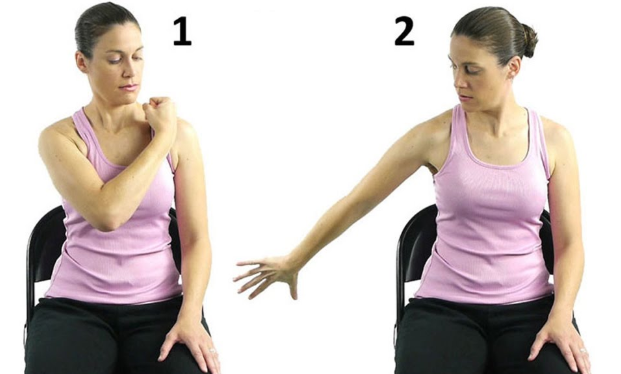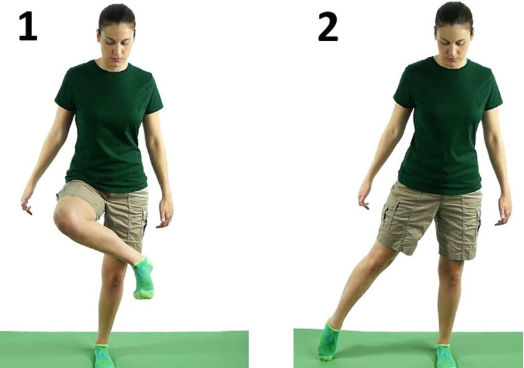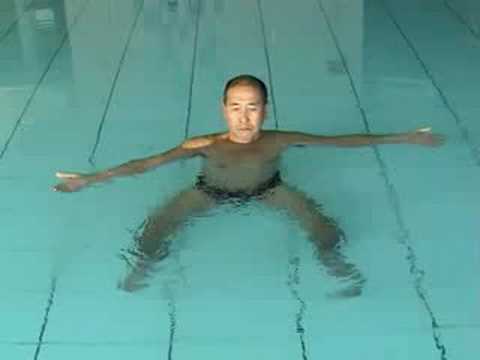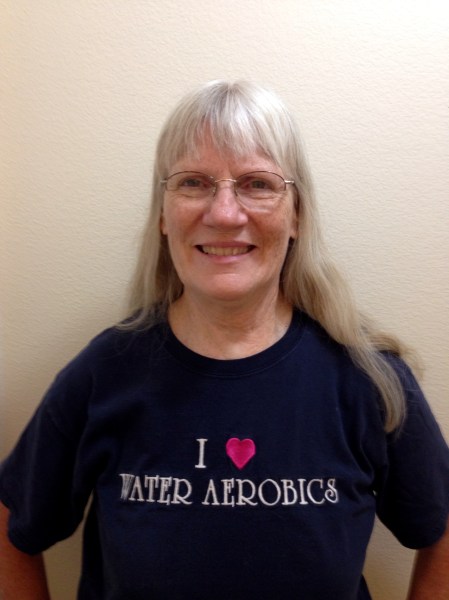
Stretching keeps the muscles flexible and healthy, and maintains the range of motion in our joints. Without stretching our muscles shorten and become tight. The American College of Sports Medicine recommends stretching at least 2-3 times a week and notes that daily stretching is the most effective. Most adults should hold a stretch 10-30 seconds, but older adults get greater benefits from holding the stretch for 30-60 seconds. Bring the stretch to your full range of motion, but not past the point of pain. Avoid bouncing, which could lead to an injury. The other way to stretch is to slowly move a joint through its full range of motion. It is important to warm up the muscles before you begin to stretch. That means that for water fitness participants, the ideal time to stretch is at the end of class.
Muscles that need stretching include the gastrocnemius (calf), hamstrings, quadriceps, iliopsoas (hip flexors), adductors (inner thigh), gluteus medius (outer thigh), trapezius (upper back), pectorals (chest), anterior deltoids (front of shoulder), sternocleidomastoid (side of the neck), erector spinae (lower back) and obliques (waist). You probably don’t have time to stretch all of those at the end of class, but you can stretch the muscles that you worked especially hard that day. Sometimes instructors get in a rut of performing the same stretches – calf stretch, quad stretch, clasp the hands behind the back – all the time. One way to mix it up is to stretch a muscle you don’t usually include, like holding a side lunge to stretch the inner thigh, or giving yourself a hug to stretch the upper back, or bringing the ear toward the shoulder to stretch the neck. Here are some other ideas:
Use the Pool Wall. For the front of the shoulder, face the wall, stretch one arm to the side with the palm on the wall; turn away from that shoulder. For the hamstrings, place the bottom of the foot on the wall at hip level, then hinge forward from the hips. For the calf, do the runner’s stretch. For the hip flexors, stand close to the wall and lift one straight leg to the back, pushing the hip toward the wall. For the quadriceps, turn your back to the wall and place the bottom of the foot on the wall. For the waist, turn one side to the wall and place that hand on the deck, stretch the other arm overhead and lean in toward the wall.
Noodle Assisted Stretches. You can stretch the leg with a noodle under the thigh. It may be difficult for some participants to thread the noodle under the thigh, but most people can straddle the noodle like a bicycle. From that position it is easy to push the noodle under the thigh. Straighten the leg to stretch the hamstrings. Some participants will be able to push the noodle to the ankle for this stretch. If they can put the noodle under the ankle, pivoting and bringing the knee down becomes a noodle assisted quad stretch. With the noodle under the thigh, open the hip and bring the knee to the side to stretch the inner thigh. Sit on the noodle like a bicycle and put one ankle on the opposite knee to stretch the outer thigh. Still sitting on the noodle, grasp the noodle with both hands behind the back and push it toward the floor to stretch the chest. Hold the noodle in the hands like a rainbow and lean to one side to stretch the waist. Or stretch the waist by placing the rainbow on the surface of the water and rotating in a slow waist twist.
Dynamic Stretches. This means moving a joint slowly through its full range of motion. If the pool water is cool, dynamic stretches are the way to go. Extend the left arm to the side with the thumb up and walk in a clockwise circle to stretch the front of the shoulder; with the right arm walk counterclockwise. Make big figure eights with the arms to stretch the shoulders. Walk forward with the arms pointing down at an angle to the sides, dragging the arms behind you to stretch the chest. Swing one leg forward and back through its full range of motion for the hip flexors. Do a slow pendulum side to side for the inner and outer thighs. Or swing one leg to the side, cross it in front of the other foot, swing it back to the side and then cross it behind the other foot. A crossover step stretches the outer thigh.
Ai Chi. These slow gentle movements are a form of dynamic stretching originated by Jun Konno in Japan. Ruth Sova gave the postures their names. The movements are breath centered and performed in flowing patterns. There are 19 postures, or movements, some for the upper body, some for the lower body. You can do an entire class of Ai Chi, or you can do some of the postures for stretching and relaxation at the end of class. Click on Jun Konno to see a 9 minute-30 second video demonstration. For more information you can purchase Ruth Sova’s Book Ai Chi: The Water Way to Health and Healing.
Yoga Poses. Water Yoga is another option for adding variety to the stretching part of a class. Many poses are performed standing, such as Mountain, Chair, Goddess, Triangle, Warrior I and Warrior II. Some are balance poses such as Tree, Side Leg Lift, Half Moon. Figure Four, Dancer and Warrior III. You can do poses without equipment, or you can add props like noodles or kickboards. For more information you can click on Christa Fairbrother’s 3-minute video demonstration, or purchase her book Water Yoga: A Teacher’s Guide to Improving Movement, Health and Wellbeing.
Proprioceptive neuromuscular facilitation (PNF) Stretching. This may be the most effective technique for increasing range of motion. It involves moving the shoulder joint or hip joint in diagonal patterns through all three planes of motion. There are two diagonal patterns for the upper extremity, called D1 UE and D2 UE; and two diagonal patterns for the lower extremity called D1 LE, and D2 LE. Click on the links at the name of each stretch for short videos on how to perform the four patterns.
Controlled Articular Rotations (CARS). These are rotations around a joint either toward or away from the midline of the body. They are called controlled because they are performed slowly in order to flood the joint with synovial fluid. These motions improve the mobility of the joint. Rotations can be performed with ten joints: neck, thoracic spine, shoulders, scapula, elbow, wrist, hip, knee, ankle, and lumbar spine. To see video demonstrations of each of these movements, click on Larissa Armstrong-Kager, a practitioner of this technique.
As you can see, there are multiple options for the stretches at the end of your water fitness class. Try something new and let me know how it went. See you in the pool!






